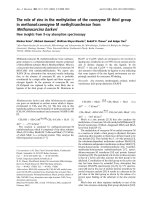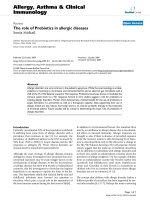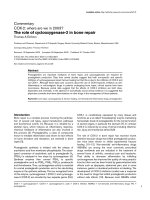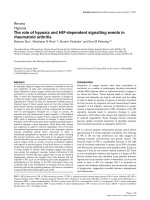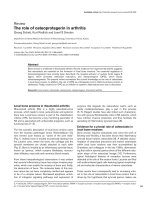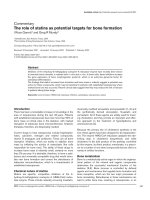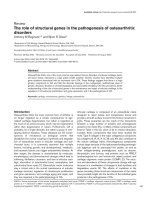Báo cáo y học: "The role of a pseudocapsula in thymic epithelial tumors: outcome and correlation with established prognostic parameters. Results of a 20-year single centre retrospective analysis" pptx
Bạn đang xem bản rút gọn của tài liệu. Xem và tải ngay bản đầy đủ của tài liệu tại đây (365.35 KB, 10 trang )
BioMed Central
Page 1 of 10
(page number not for citation purposes)
Journal of Cardiothoracic Surgery
Open Access
Research article
The role of a pseudocapsula in thymic epithelial tumors: outcome
and correlation with established prognostic parameters. Results of a
20-year single centre retrospective analysis
Sebastian Dango*
1
, Bernward Passlick
1
, Ulf Thiemann
2
, Gian Kayser
2
and
Christian Stremmel
1
Address:
1
Clinic for Thoracic Surgery, Hugstetter Str. 55, University Hospital Freiburg, Albert-Ludwig-University, 79106 Freiburg, Germany and
2
Pathological Institut of University Hospital Freiburg, Breisacherstr. 115, Albert-Ludwig University, 79106 Freiburg, Germany
Email: Sebastian Dango* - ; Bernward Passlick - ;
Ulf Thiemann - ; Gian Kayser - ;
Christian Stremmel -
* Corresponding author
Abstract
Background: Treatment of thymoma is often based on observation of only a few patients. Surgical
resection is considered to be the most important step. Role of a pseudocapsula for surgery, its
clinical significance and outcome compared with established prognostic parameters is discussed
which has not been reported so far.
Methods: 84 patients with thymoma underwent resection and analysis was carried out for clinical
features, prognostic factors and long-term survival.
Results: Fifteen patients were classified in WHO subgroup A, 21 in AB, 29 in B and 19 patients in
C. Forty two patients were classified in Masaoka stage I, 19 stage II, 9 stage III and 14 stage IV.
Encapsulated thymoma was seen in 40, incomplete or missing capsula in 44 patients. In 71 complete
resections, local recurrence was 5%. 5-year survival was 88.1%. Thymomas with pseudocapsula
showed a significant better survival (94.9% vs. 61.1%, respectively) (p = 0.001) and was correlated
with the absence of nodal or distant metastasis (p = 0.04 and 0.001, respectively). Presence of
pseudocapsula as well as the Masaoka and WHO classification, and R-status were of prognostic
significance. R-status and Masaoka stage appeared to be of independent prognostic significance in
multivariate analysis.
Conclusion: Intraoperative presence of an encapsulated tumor is a good technical marker for the
surgeon to evaluate resectability and estimate prognosis. Although the presence of a capsula is of
strong significance in the univariate analysis, it failed in the multivariate analysis due to its
correlation with clinical Masaoka stage. Masaoka stage has a stronger relevance than WHO
classification to determinate long-term outcome.
Published: 15 July 2009
Journal of Cardiothoracic Surgery 2009, 4:33 doi:10.1186/1749-8090-4-33
Received: 6 October 2008
Accepted: 15 July 2009
This article is available from: />© 2009 Dango et al; licensee BioMed Central Ltd.
This is an Open Access article distributed under the terms of the Creative Commons Attribution License ( />),
which permits unrestricted use, distribution, and reproduction in any medium, provided the original work is properly cited.
Journal of Cardiothoracic Surgery 2009, 4:33 />Page 2 of 10
(page number not for citation purposes)
Introduction
Although thymoma is with 50% the most common tumor
of anterior mediastinum clinical management has been
based largely on observations in a few single-centre expe-
riences. The largest studies were performed in Japan. Thy-
momas are compulsory malignant tumors with an
incidence of 0.2 – 1.5% worldwide [1]. A larger body of
literature has been presented in the last decades providing
further insight into tumor biology and clinical behaviour
of thymomas [2]. Only a few reports include a significant
number of patients with thymomas that have followed up
for a sufficient five year period. Regarding the clinical
approach different concepts are emerging as a result of a
more evidence-based clinical management. Surgery is the
gold standard of treatment. Herein, we present a 20 year
experience in clinical treatment of thymomas as a result of
a retrospective single centre analysis done within a Euro-
pean university setting. The role of a pseudocapsula and
its clinical significance and outcome compared with
established prognostic parameters is discussed which has
not been reported so far.
Materials and methods
Patients
Patient data were collected using a questionnaire that was
developed for this study and approved by the local ethics
committee. A retrospective review of surgical records at
the Department of Thoracic Surgery, University of
Freiburg identified a total number of 84 patients who had
received surgical treatment for thymoma between 1984
and 2004. Only histologically confirmed cases were
included. A performed neoadjuvant or adjuvant treatment
was documented. Follow-up data were obtained through
the department's archives or, after informed consent, the
patients themselves or, if deceased, their relatives or fam-
ily physicians.
Overall 46 patients were male, 38 were female. The age of
the patients ranged from 14 to 82 years (median 58 years).
Also patients with a neoadjuvant or adjuvant treatment
were included in the study. Two patients were excluded
for further analysis because of incomplete follow-up;
overall 82 patients were introduced to survival analysis.
Clinical Pathology and Immunhistochemical Staging
Hematoxylin-eosin-stained sections of all patients were
available for the re-evaluation of the histologic diagnosis
according to the commonly known WHO schema of 1999
[2-4]. Additionally special immunhistochemical staining
was performed for Zytokeratin, Neuron-specific enolase
(NSE), cluster of differentiation (CD) 1a, 3, 5, 20 and 117
(c-kit). The histological evaluation was carried out by two
independent senior pathologist at the Department of
Pathology, University of Freiburg, without any informa-
tion about the patient's clinical features.
The classification proposed by Masaoka was adopted to
determine the tumor stage as described elsewhere [5,6].
This staging system is based on the extent of macroscopic
or microscopic invasion in mediastinal structures. The
clinical stage was thus determined by critical review of sur-
gical records and pathology reports. Further more, R-, N-
and M-Status was classified in addition to a local infiltra-
tion of vessels and pericardium and the presence of a
pseudocapsula was taken into analysis. Possible other
clinical relevant features such as myasthenia gravis were
recorded as well as surgical complications.
Statistical Analysis
For all statistical analysis SPSS 14.0 software (SPSS Inc.,
Chicago, IL, USA) was used. p < 0.05 was assumed signif-
icant unless otherwise stated. The above named perime-
ters were taken into statistical investigation and possible
correlation was analysed using Pearson's Chi
2
-test. Over-
all survival time was calculated from the date of surgery to
death or last follow-up. Observations of living patients
were arrested on database and continually actualised.
Overall subgroup for each spectrum was determinate and
a survival analysis was performed. Deaths related to the
tumor were considered events; all deaths not related were
considered as censored observations. Survival rates were
calculated with the Kaplan-Meier method, statistical dif-
ference in survival was determined by using the log-rank
test and in case of significance a univariate analysis and
Cox-regression analysis was carried out.
Results
Pathological and Clinical Findings
According to the WHO classification 15 tumors were clas-
sified as type A, 21 tumors were type AB, 13 patients with
type B1, 13 with type B2, 3 type B3 tumors and 19 (20%)
patients with type C tumors. Out of these 19 types C
tumors 5 (25%) were histologically diagnosed as thymic
carcinoid. Clinical staging according to Masaoka showed
that 42 patients were classified in stage I, 19 patients in
stage II, 9 in stage III and 8 and 6 were referred to IVa or
IVb, respectively (Table 1). 85% of the patients staged in
WHO A-B2 were classified in Masaoka stage I and II.
Nineteen patients presented with myasthenia gravis.
Other clinical features were as follows: chest discomfort
(10 patients), thoracic pain (7), weight loss (3), or other
symptoms (vena cava superior syndrome, bleeding).
Thirty two patients did not present any clinical symptoms
and in 5 cases eventually presences of clinical symptoms
were unclear.
Complete resection (R0) was achieved in 71 patients
(84%), R1- and R2-resections were carried out in 5 (6%)
and 8 (10%) patients, respectively (Table 2).
Journal of Cardiothoracic Surgery 2009, 4:33 />Page 3 of 10
(page number not for citation purposes)
Local recurrence depended on the stage and was noted in
2 patients (1.7%). 1 patient in Masaoka stage II appeared
to have a local recurrence after 79 month, another patient
in Masaoka stage IVa after 11 month. Both, R-status and
local recurrence were dependent on the Masaoka stage (p
< 0.001).
An involvement of adjacent anatomical structures was
found overall in 53 patients including the pleura, peri-
card, vessels or neighboured lung tissue. All patients were
staged Masaoka IV, only one case with involvement of the
vena anonyma was staged Masaoka III. Two patients pre-
sented with an infiltrating tumor of pericardium and ner-
vus phrenicus. Infiltration of pericardium was correlated
with the WHO classification (p < 0.001).
Encapsulated tumor with presence of a complete or
incomplete pseudocapsula was identified in 66 patients
(78.6%). In detail, with 40 patients the majority of thy-
momas were encapsulated totally, 26 were incomplete
structured and in 18 cases presence of a capsula was miss-
ing. A correlation was seen between the presence of a
pseudocapsula and Masaoka as well as WHO classifica-
tion (p = 0.001) (Table 3). Presence of a pseudocapsula
had influence on N-status, M-status, infiltration of peri-
cardium or surrounded vessels and local recurrence (Table
3). In 79 patients there was no lymph node involvement
and in 5 cases a local lymph node metastasis was found
(N1). None presented with an ipsilateral (N2) or clinical
seen contralateral lymph node metastasis (N3). Distant
metastases (M1) were collected in 8 patients with thymic
tumors. Eight metastases were found; four patients
appeared to have a systemic disease with multiple metas-
tases. Single metastasis was situated either in the pleura,
liver or lung. Pleural metastasis was seen in 1 case, further
more 2 metastases were found in the lung and 1 metasta-
sis in the liver. Recurrence was only seen in one case each
in patients with an incomplete encapsulated thymoma or
a missing capsula.
Neo-Adjuvant and Adjuvant Therapy
As far as a neoadjuvant or adjuvant therapy is concerned
two major aspects must be figured out. First, clear indica-
tions are essential, second, a potential benefit for sub-
groups must be analysed. Therefore, we performed
subgroup analyses and evaluated clinical findings as
present Masaoka stage compared to given treatment to
define possible benefit for survival.
8 patients were included into a neoadjuvant treatment
regime inclusive chemotherapy and/or radiation therapy,
33 patients were taken into an adjuvant therapy regime. In
detail, 3 patients were either treated alone with neoadju-
vant chemotherapy or radiation alone, one patient
received combined treatment, and in another patient an
immunotherapy was performed. Adjuvant radiation was
executed in 26 cases, chemotherapy alone was given in 5
cases, and a combination of both was performed in 2
patients. Interestingly, 2 patients in stage IV were resected
R0 after neoadjuvant chemotherapy which was carried on
after surgery. No immunotherapy was carried out as adju-
vant treatment regime. Five patients were taken to adju-
Table 1: Clinical features of different thymoma subtypes classified according WHO
a
WHO n Age (yr) MG
b
(%) Weight (g) Masaoka
I
Masaoka
II
Masaoka
III
Masaoka
IV
A 15 64.0 ± 9.8 26.6 164.0 ± 293.0 10 4 1 0
AB 21 58.5 ± 10.6 14.2 114.0 ± 131.4 15 2 4 0
B11358.6 ± 6.323.0103.0 ± 99.59211
B21351.8 ± 20.353.0125.0 ± 108.65602
B3367.8 ± 23.466.6166.0 ± 83.51200
C 19 54.1 ± 13.4 0 139.0 ± 403.4 2 3 3 11
Total 84 - 22.6 - 42 19 9 14
a
Data are presented as mean ± SD unless otherwise indicated.
b
Myasthenia gravis
Table 2: Clinical features of different thymoma classified according Masaoka Stage
a
Masaoka n R0-status N1 M1 Recurrence 5-year survival (%)
I 42 42 (100%) 0 (0%) 0 (0%) 0 (0%) 97.6
II 19 18 (94.7%) 0 (0%) 0 (0%) 1 (5.3%) 94.7
III 9 6 (66.7%) 0 (0%) 0 (0%) 0 (0%) 66.7
IV 14 5 (35.7%) 6 (42.8%) 8 (57.1) 1 (7%) 64.3
a
Data are presented as mean ± SD unless otherwise indicated
Journal of Cardiothoracic Surgery 2009, 4:33 />Page 4 of 10
(page number not for citation purposes)
vant systemic therapy alone and 2 patients received
combined radiotherapy in stage IV. No chemotherapy was
performed in Masaoka stage I-III. There was no local
recurrence in patients staged Masaoka I or III in our study
group.
Patients with complete encapsulated thymoma did not
receive neoadjuvant treatment, only one patient needed
radiation after surgery. 44 patients with incomplete or
missing capsula were taken into neoadjuvant or adjuvant
treatment. In detail, 7 patients without a capsula received
neoadjuvant including immunotherapy in one case. 25
patients (15 with incomplete capsula and 10 with no cap-
sula) were taken into adjuvant radiation, 2 patients with
no capsula into ongoing chemotherapy after surgery.
Survival Analysis and Prognostic Factors
For incomplete follow-up or cancer-unrelated death two
out of 84 patients were excluded from survival analysis
and 82 patients were determined for further investigation.
Overall survival was 88.1% after 45 month. Age, sex, clin-
ical staging through Masaoka, WHO classification, R-sta-
tus, encapsulated or non-encapsulated thymoma as well
as the N- and M-status and local recurrence was statisti-
cally reviewed. Local recurrence for patients with a per-
formed R0-resection was found in 2 cases (2.7%) within
follow-up of 45 month and had no influence on overall
survival. In Masaoka stage I an overall survival rate of 59.2
month, in stage II of 58.5 month, in stage III of 47.7
month and in Masaoka stage IV survival rate of 49.8
month were found (Fig. 1). The 5-year survival rate
decreased from over 94% in Masaoka stage I and II to less
than 67% in Masaoka stage III and IV (Table 2) WHO clas-
sification reflects decreased overall survival in further
ranked WHO classes (p = 0.003, figure not shown). Sub-
group analysis showed an unfavourable outcome with sig-
nificant difference in class A-B2 and B3-C (p < 0.002, 58
vs. 50 month) (Fig. 2). Patients with complete encapsu-
lated tumors lived for 59 month and with incomplete cap-
sula for 58 month, difference was statistically not
significant. But patients with a missing pseudocapsula
showed an unfavourable outcome compared to an encap-
sulated tumor with an overall survival of 44 month (p <
0.001) (Fig. 3). An achieved R0-state improves surgical
outcome (Fig. 4) with a significant survival advantage for
the patient (p < 0.001, std. deviation 4.92, confidence
interval 95%: 34.8–54.1). A performed analysis to evalu-
ate a difference between R1- compared to a R2-resection
of 13 patients failed showing any relevant difference in
patients' outcome (p = 0.39). Automatically, no influence
on survival was seen for patients with performed biopsy.
Patients with clinical finding of Myasthenia gravis did also
not have a survival advantage (p = 0.46). Histological
appearance according to Bernatz and Marino or Müller-
Hermelink did not appear to have any clinical or prognos-
tic relevance in the performed statistical investigation and
was not taken into further analysis (p = 0.25). Also the
immunohistochemestry (NSE, Cytokeratin, CD1a, 3, 5,
20 and 117) did not show any prognostic relevance.
Subgroup analysis was carried out to determine an advan-
tage for patients with neoadjuvant or adjuvant treatment.
Table 3: Patient characteristics and tumor parameters according to the presence of a pseudocapsula
a
Characteristics n Pseudocapsula
complete
Pseudocapsula
incomplete
Pseudocapsula
no capsula
p-value
b
Masaoka I 42 38 4 0 0.001
II191162
III9135
IV 14 0 3 11
N-status N0 79 40 24 15 0.042
N15023
M-status M0 76 40 25 11 0.001
M1 8 1 7
Vessel infiltration 13 0 3 9 0.001
Pericard infiltration 14 1 1 12 0.001
Recurrence 2 0 1 1 0.047
Age (yr)
c
84 40 26 18 0.44
Sex Male 45 14 17 14 0.004
Female 39 26 9 4
MG
d
19 10 6 3 0.86
a
Data are presented as mean ± SD unless otherwise indicated
b
Two-sided p values were calculated by Pearson's Chi-Square test to determine the significance of correlation of clinicopathological parameters and
presence of a pseudocapsula of the tumor.
Boldprinting indicates statistical significance
c
Range from 14 to 82 years
d
Myasthenia gravis
Journal of Cardiothoracic Surgery 2009, 4:33 />Page 5 of 10
(page number not for citation purposes)
Subgroup analysis showed only significant favourable
clinical outcome by adjuvant therapy for patients with
thymic tumors in Masaoka Stage III (p = 0.014).
Factors of prognostic impact were evaluated in the popu-
lation. Present symptoms, patient's age, as well as resected
tumor mass, possible lymph node involvement and dis-
tant metastasis and infiltration of adjacent structures did
not have any prognostic influence. Regression analysis
demarked a significant correlation only for vessel infiltra-
tion and prognosis (p = 0.027). Strong prognostic impact
was found for Masaoka staging system (p < 0.001). WHO
classification stresses poor prognosis of related patients (p
= 0.002). Surgical outcome measured by resection state
appeared as the strongest significant prognostic parameter
in the population (p < 0.001). Multivariate analysis was
performed to figure out possible correlations with WHO
classification and Masaoka Staging system as well as pres-
ence of a pseudocapsula. Joint-effects were analysed by
Cox-Regression and independence was found for resec-
tion state and Masaoka (Table 4). An increased risk for
increased cancer-related death of almost four times was
figured out for incomplete compared to complete resec-
tion. A relative risk for decreased survival of over two was
found for increased Masaoka stage of patients with thy-
moma. WHO reflects biological behaviour as well as
tumors' aggressiveness and went confirm with Masaoka
staging and clinical outcome not being of prognostic
independence.
An encapsulated tumor presented a better clinical out-
come than loss of a pseudocapsula (p < 0.001). Thymoma
with complete or incomplete capsula showed a statisti-
cally significant better survival than without pseudocao-
sula (94.9% vs. 61.1%; p = 0.001) which reflects the
Masaoka staging system. Survival analysis showed a better
Overall survival according to clinical Masaoka stageFigure 1
Overall survival according to clinical Masaoka stage.
Journal of Cardiothoracic Surgery 2009, 4:33 />Page 6 of 10
(page number not for citation purposes)
outcome after surgery in patients with encapsulated
tumor which results in less lymph node metastases, less
distant metastases and less infiltration of surrounded ves-
sels and pericardium. Patients in Masaoka stage IV had
more often a non-encapsulated tumor with increased can-
cer related death (Table 3). Interestingly, complete or
incomplete encapsulated thymomas required less often a
neoadjuvant or adjuvant treatment with better prognosis
(p < 0.002). This correlation was not independent in the
performed multivariate analysis.
Summarized, Masaoka stage is of stronger significance in
patients with a thymoma compared to WHO classifica-
tion. Surgery with complete resection is a very favourable
cancer-related prognostic factor in patients with thy-
moma.
Discussion
Thymoma is a rare tumor entity and clinical management
is very often based on observations of only a few patients
in a single center. Surgery is considered the mainstay of
therapy and recurrence is described as a typical nature of
this tumor [1,3,7-11]. Presence of a pseudocapsula influ-
ences therapy regime and clinical outcome. Thymomas
vary in its biological behaviour; also biology of this malig-
nancy is still not fully understood. Two major classifica-
tions for thymomas are important and help to find the
best therapy adapted to the prognosis.
Overall survival according WHO classification A-B2 and B3-CFigure 2
Overall survival according WHO classification A-B2 and B3-C.
Journal of Cardiothoracic Surgery 2009, 4:33 />Page 7 of 10
(page number not for citation purposes)
In this series we found an overall survival of 88.1% which
is representative to described data in the literature [1-
3,5,7-12]. Vessel infiltration as well as Masaoka stage,
WHO classification, R-status and an encapsulated tumor
were of prognostic significance. Multivariate analysis was
carried out to analyze possible joint-effects of prognostic
parameter and only R-status and Masaoka stage appeared
to be of independent prognostic significance in our series.
Even though being of strong significance in the univariate
survival analysis WHO classification was not independent
in the Cox-regression analysis. For clinical use and estima-
tion of the patients' prognosis WHO classification is not
as useful as the Masaoka classification which was shown
before [3]. The reason for these is based in a couple of
problems. First, there is a significant interobserver varia-
bility in histological typing [2,6]. Second, determination
of precise cut-off points between different categories (e.g.
B1 to B2, or B2 to B3) may lead to different categorisation,
especially in highly biological active tumors such as B3
thymomas [3]. Third, proportion of the invasive tumors is
not reflected in the WHO classification, and therefore,
prognostic value is not preciously mirrored [4,13].
Kim reported a simplification classifying thymomas into
different groups; A-B2 on the one side and B3 and C thy-
momas on the other side [3]. We used this simplification
for statistical analysis and presentation of clinical features
(Table 1). It better reflects real survival rates and progno-
sis, as shown previously [1,3,14]. There is a significant dif-
ference between cancer-related survival for patients
according to WHO classification A-B2 and B3-C. Progno-
sis is good in patients with type A to B2 thymomas with
no tumor related death. In our cohort survival rate was
over 95% for WHO A-B2 and only 68% for B3-C. Several
investigators have also reported poor prognosis of type B3
thymoma [1-3,10], whereas no difference is found in oth-
ers reports in the literature concerning B2 and B3 thymo-
Overall survival according presence of complete/incomplete capsulaFigure 3
Overall survival according presence of complete/incomplete capsula.
Journal of Cardiothoracic Surgery 2009, 4:33 />Page 8 of 10
(page number not for citation purposes)
mas [15-17]. In our study group 84% of patients in WHO
A to B2 were classified into Masaoka stage I or II. There-
fore, the shown joint effect in multivariate analysis due to
a large overlap between different subgroups of WHO and
early Masaoka stages is easily explained.
Masaoka staging system was the strongest independent
factor for survival additional to the R-status in our study
group. Large thymomas in advanced Masaoka stages are
not very likely to be resected R0 and thus having a
decreased outcome [18].
In our study population an encapsulated tumor is associ-
ated with a decreased cancer-related survival compared to
a thymoma without a capsula. In complete or incomplete
encapsulated thymomas survival rate is 97% and 92%,
respectively, while survival rate without a capsula is lightly
over 60%. Also being of strong significance in the univar-
iate analysis, presence of a pseudocapsula fales as inde-
pendent prognostic parameter in the multivariate analysis
due to its narrow correlation with the clinical Masaoka
stage. However, correlation with Masaoka can easily be
explained. A pseudocapsula borders the tumor and limits
local infiltration and reflects a less aggressive behaviour.
Thus, less lymph node or distant metastases and infiltra-
tion of adjacent structures like pericardium or vessels are
found (Table 3). Therefore, intraoperative presence of an
encapsulated tumor is a good technical marker for the sur-
Overall survival according resection status (R-status)Figure 4
Overall survival according resection status (R-status).
Journal of Cardiothoracic Surgery 2009, 4:33 />Page 9 of 10
(page number not for citation purposes)
geon to evaluate resectability and estimate patient's prog-
nosis including recurrence. This reason emphasizes the
importance of a capsula for Masaoka staging.
In our population 26 patients were additionally treated
with radiation, out of these 2 patients in stage IV were
taken into combined radiochemotherapy after surgery.
Subgroup analysis showed significant favourable out-
come through adjuvant therapy only for patients with
thymic tumors staged Masaoka III. Thymomas are radio-
sensitive, and radiotherapy (RT) is generally accepted for
advanced stages after partial resection [19-22]. However,
strong evidence for this is still missing and efficacy is hard
to define because of small numbers of patients in the pre-
sented studies. Therefore, whether adjuvant RT should be
given after resection remains controversial, especially all
series addressing postoperative RT involve retrospective
reviews including many decades rather than an experience
with a defined treatment plan and selection criteria [23].
In complete resected thymomas recurrence rate for stage I
and II is so low without adjuvant RT, that the use of RT
after surgery can not be recommended [7]. For sure, adju-
vant radiation is compulsory for incomplete resection also
not showing a better survival. But adjuvant radiation was
found to result in lower recurrence rate in patients with
incomplete resected thymomas in stage IV [23,24].
In our study chemotherapy was given in 5 cases only in
stage IV and recurrence rate was 7%. No patients in Masa-
oka stage I-III received neoadjuvant or adjuvant chemo-
therapy. We did not find any survival advantage for
patients with either neoadjuvant or adjuvant systemic
treatment. These findings reflect results presented in the
literature. Generally, thymomas in stage III and IV do not
appear to have a better outcome for adjuvant chemother-
apy compared to surgery alone, but in the biggest pre-
sented study so far by Kondo a survival advantage was
seen for thymic carcinomas [7].
Multimodality treatment consisting of preoperative chem-
otherapy, surgery and adjuvant RT was carried out in 2
patients in our study group. There was no survival benefit
for this subgroup also the number of patients is extremely
small. Interestingly, 2 patients in stage IV were resected R0
after neoadjuvant chemotherapy. Adjuvant treatment was
carried on with chemotherapy and therefore leads to a
better survival through multimodal therapy. Generally,
the position of a multimodality treatment is still discussed
controversially because of only small heterogeneous
number of patients in the presented literature. A possible
resection and survival might be improved in patients with
stage III and IV thymomas as reported in the literature
[11,25]. Prospective studies showed increased resectabil-
ity up to 72% with an average 5-year survival rate of 78%
[7,11,14]. Therefore, a multimodal treatment regime
appears to have a slightly better survival for patients in
stage III and IV than for patients with surgery alone, inde-
pendent, if postoperative RT alone or combined radio
chemotherapy is used [7,11,14,25].
Summarized, the shown data confirm the published
results on the clinical prognosis of different histological
subtypes and the difficulties with the staging systems. Fur-
ther more, our data point out a difference in survival and
prognosis when tumor is complete or incomplete encap-
sulated stressing the importance of knowledge of pres-
ence. According to our opinion, differentiated
pathological assessment for pseudocapsula can surely
improve clinical evaluation of surgical outcome and is
therefore compulsory. The strongest impact on survival is
surely a complete resection, which is dependent on Masa-
oka staging. Prognosis can be evaluated best by carrying
out the Masaoka staging. Moreover, WHO classification is
not as precise as the Masaoka classification for prediction
of prognosis of the patient which is for clinical manage-
ment still the best. To our opinion pathologically con-
firmed complete encapsulated tumors do not require any
Table 4: Univariate and multivariate analysis of cancer-related survival in the total population
a
Risk factor Univariate analysis Multivariate analysis
c
p value
b
Relative risk 95% Confidence interval p value
R-status 0.0001 3.9 2.0 – 7.6 0.001
Masaoka staging
d
0.0001 2.0 1.0 – 4.1 0.020
Presence of a pseudocapsula 0.0002 - - 0.179
WHO
d
classification
e
0.0001 - - 0.181
Sex 0.562 - - 0.849
Age 0.360 - - 0.206
a
Cancer-unrelated death or incomplete follow-up resulted in exclusion of 2 patients leaving 82 patients available for the analysis of joint effects of
prognostic parameter.
b
p values of univariate analysis were determined by Log rank test.
c
Stepwise multivariate analysis was performed using the Cox prpotional-hazard model.
d
WHO classification was grouped into two major classes: A-B2 and B3-C.
e
Masaoka and WHO did show joint effects with pseudocapsula and were therefore not taken to further analysis.
Journal of Cardiothoracic Surgery 2009, 4:33 />Page 10 of 10
(page number not for citation purposes)
neo- or adjuvant treatment after complete resection. The
worse survival results for the higher Masaoka stages sup-
port a combined therapy with neoadjuvant chemotherapy
and adjuvant radiotherapy which is supported by the lit-
erature [14]. More prospective randomized trials are
essential to clarify possible beneficial effects for advanced
thymomas or thymuscarcinomas.
Conclusion
Intraoperative presence of an encapsulated tumor is a
good technical marker for the surgeon to evaluate respect-
ability and estimate prognosis. Although the presence of a
capsula is of strong significance in the univariate analysis,
it failed in the multivariate analysis due to its correlation
with clinical Masaoka stage. Masaoka stage has a stronger
relevance than WHO classification to determinate long-
term outcome.
Competing interests
The authors declare that they have no competing interests.
Authors' contributions
SD has conceived the study, participated in the design,
carried out statistical analysis, mainly composed the man-
uscript and performed administrational and institutional
work. BP is the Head of Department and reviewed the
manuscript and gave scientific impact. UT acquired the
data retrospectively. GK as pathologist classified thymo-
mas and reviewed histological and immunhistochemical
staining of the specimens. CS has participated as senior
author in the design of the study and helped to draft the
manuscript. All authors read and approved the final man-
uscript
References
1. Okumura M, Miyoshi S, Fujii Y, Takeuchi Y, Shiono H, Inoue M, Fuku-
hara K, Kadota Y, Tateyama H, Eimoto T, Matsuda H: Clinical and
functional significance of WHO classification on human
thymic epithelial neoplasms: a study of 146 consecutive
tumors. Am J Surg Pathol 2001, 25(1):103-10.
2. Detterbeck FC, Parsons AM: Thymic tumors. Ann Thorac Surg
2004, 77(5):1860-9.
3. Kim DJ, Yang WI, Choi SS, Kim KD, Chung KY: Prognostic and
clinical relevance of the World Health Organization schema
for the classification of thymic epithelial tumors: a clinico-
pathologic study of 108 patients and literature review. Chest
2005, 127(3):755-61.
4. Dadmanesh F, Sekihara T, Rosai J: Histologic typing of thymoma
according to the new World Health Organization classifica-
tion. Chest Surg Clin N Am 2001, 11(2):407-20.
5. Lardinois D, Rechsteiner R, Läng RH, Gugger M, Betticher D, von
Briel C, Krueger T, Ris HB: Prognostic relevance of Masaoka
and Muller-Hermelink classification in patients with thymic
tumors. Ann Thorac Surg 2000, 69(5):1550-5.
6. Dawson A, Ibrahim NB, Gibbs AR: Observer variation in the his-
topathological classification of thymoma: correlation with
prognosis. J Clin Pathol 1994, 47:519-23.
7. Kondo K, Monden Y: Therapy for thymic epithelial tumors: a
clinical study of 1,320 patients from Japan. Ann Thorac Surg
2003, 76(3):878-84. discussion 884–5
8. Lopez-Cano M, Ponseti-Bosch JM, Espin-Basany E, Sanchez-Garcia JL,
Armengol-Carrasco M: Clinical and pathologic predictors of
outcome in thymoma-associated myasthenia gravis. Ann Tho-
rac Surg 2003, 76(5):1643-9.
9. Maggi G, Casadio C, Cavallo A, Cianci R, Molinatti M, Ruffini E: Thy-
moma: results of 241 operated cases. Ann Thorac Surg 1991,
51(1):152-6.
10. Okumura M, Ohta M, Tateyama H, Nakagawa K, Matsumura A,
Maeda H, Tada H, Eimoto T, Matsuda H, Masaoka A: The World
Health Organization histologic classification system reflects
the oncologic behavior of thymoma: a clinical study of 273
patients. Cancer 2002, 94(3):624-32.
11. Venuta F, Rendina EA, Longo F, De Giacomo T, Anile M, Mercadante
E, Ventura L, Osti MF, Francioni F, Coloni GF: Long-term outcome
after multimodality treatment for stage III thymic tumors.
Ann Thorac Surg 2003, 76(6):1866-72.
12. Blumberg D, Port JL, Weksler B, Delgado R, Rosai J, Berins MS, Gins-
berg RJ, Martini N, McCormat PM, Rusch V: Thymoma: a multi-
variate analysis of factors predicting survival. Ann Thorac Surg
1995, 60(4):908-13.
13. Lewis JE, Wick MR, Scheithauer BW, Bernatz PE, Taylor WF: Thy-
moma. A clinicopathologic review. Cancer 1987,
60(11):2727-43.
14. Rea F, Sartori F, Loy M, Calabrò F, Fornasiero A, Daniele O, Altavilla
G: Chemotherapy and operation for invasive thymoma. J
Thorac Cardiovasc Surg 1993, 106:543-49.
15. Chalabreysse L, Roy P, Cordier JF, Loire R, Gamondes JP, Thivolet-
Bejui F: Correlation of the WHO schema for the classification
of thymic epithelial neoplasms with prognosis: a retrospec-
tive study of 90 tumors. Am J Surg Pathol 2002, 26(12):1605-11.
16. Chen G, Marx A, Wen-Hu C, Yong J, Puppe B, Stroebel P, Müller-
Hermelink HK: New WHO histologic classification predicts
prognosis of thymic epithelial tumors: a clinicopathologic
study of 200 thymoma cases from China. Cancer 2002,
95:420-29.
17. Rieker RJ, Hoegel J, Morresi-Hauf A, Hofmann WJ, Blaeker H, Penzel
R, Otto HF: Histologic classification of thymic epithelial
tumors: comparison of established classifications schemes.
Int J Cancer 2002, 98:900-06.
18. Regnard JF, Magdeleinat P, Dromer C, Dulmet E, de Montpreville V,
Levi JF, Levasseur P: Prognostic factors and long term results
after thymoma resection: a series of 307 patients. J Thorac
Cardiovasc Surg 1996, 112:376-84.
19. Nakahara K, Ohno K, Hashimoto J, Maeda H, Miyoshi S, Sakurai M,
Monden Y, Kawashima Y: Thymoma: results with complete
resection and adjuvant postoperative irradiation in 141 con-
secutive patients. J Thorac Cardiovasc Surg 1988, 95:1041-47.
20. Ogawa K, Toita T, Uno T, Fuwa N, Kakinohana Y, Kamata M, Koja K,
Kinjo T, Adachi G, Murayama S: Treatment and prognosis of
thymic carcinoma: a retrospective analysis of 40 cases. Can-
cer 2002, 94(12):3115-9.
21. Cowen D, Richaud P, Mornex F, Bachelot T, Jung GM, Mirabel X, Mar-
chal C, Lagrange JL, Rambert P, Chaplain G: Thymoma: results of
a multicentric retrospective series of 149 non-metastatic
irradiated patients and review of the literature. FNCLCC tri-
alists. Radiother Oncol 1995, 34:9-16.
22. Curran WJ Jr, Kornstein MJ, Brooks JJ, Turrisi AT: Invasive thy-
moma: the role of mediastinal irradiation following com-
plete or incomplete surgical resection. J Clin Oncol 1988,
6:1722-27.
23. Rea F, Marulli G, Girardi R, Bortolotti L, Favaretto A, Galligioni A, Sar-
tori F: Long-term survival and prognostic factors in thymic
epithelial tumours. Eur J Cardiothorac Surg 2004, 26(2):412-8.
24. Monden Y, Nakahara K, Iioka S, Nanjo S, Ohno K, Fujii Y, Hashimoto
J, Kitagawa Y, Masaoka A, Kawashima Y: Recurrence of thymoma:
clinicopathological features, therapy, and prognosis. Ann Tho-
rac Surg 1985, 39:165-69.
25. Greene MA, Malias MA: Aggressive multimodality treatment of
invasive thymic carcinoma. J Thorac Cardiovasc Surg 2003,
125(2):434-6.


